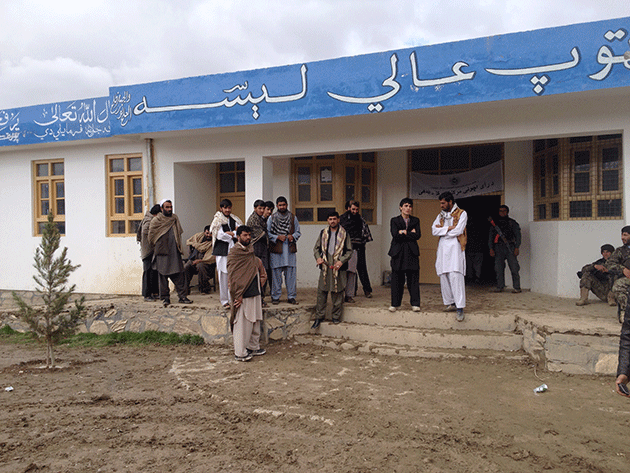Around mid-morning on Saturday, we found the ghost polling center. It was the day of the first round of voting in Afghanistan’s presidential election, and we had decided to drive out to Chak District in Wardak, a violence-wracked province that straddles the main national highway west of Kabul. Our guide, Raqib,* the commander of a U.S.-backed militia, drove us over a series of increasingly remote roads, until finally we passed a checkpoint that belonged to his men. We were at the far limit of Afghan government control; as we came around the next bend in the road, Raqib explained that the Taliban had run a checkpoint here until four days before, when a pre-election military operation had pushed them further into the hills.
* This is a pseudonym.
There was supposed to be a polling center in this area, at the village school in Ambu Khak. According to the Independent Election Commission of Afghanistan, the center would have separate stations for men and women, and would accommodate as many as 1,200 voters. But the building was shuttered, and the surrounding streets were vacant.
We drove up the hillside to an Afghan army outpost overlooking the village, where a pair of soldiers were keeping watch near an armored Humvee. With them was Nasim, who was working as a monitor for one of the presidential candidates, a former jihadi commander named Abdurrab Rasoul Sayyaf. “I came in the morning and all I saw was empty boxes,” he said. “The polling center was closed.” He pointed out a compound not far from the school. We could see a knot of men hovering near the entrance. When Nasim had showed up earlier to look for voters, he said, he saw men stuffing ballots into boxes.
“I’m sorry, but I can’t take you down there,” Raqib said, grinning apologetically. “I know them and they’ll be mad at me if I bring foreign journalists.” He and Nasim were vague when asked about the beneficiaries of the fraud, but near the compound we could see a Toyota Hilux bearing a poster of one of the Kalimzai brothers, members of a powerful local family who supported presidential candidate Zalmay Rassoul.
It was becoming clear by then that two different narratives would emerge from the election. One would take place in Afghanistan’s cities — which enjoy relative security, a vibrant press, international observers, and a developed political process, all of which helped hold the vote accountable. The other would unfold in the insecure rural areas, which are contested between the government, the Taliban, and militias. There, the election would be largely invisible to journalists and other observers.
These areas also saw frequent ballot-stuffing and other forms of fraud during the troubled 2009 presidential and 2010 parliamentary elections, each of which had nearly a million ballots disqualified. The strong correlation between insecurity and fraud stems from the threat of insurgent violence, which impedes election monitors and campaign observers, paving the way for powerful local strongmen to pressure and bribe electoral officials.
Yet the IEC had again planned to open polling centers across the insecure countryside, aiming for a total of 6,845, an increase of nearly 1,000 over 2010. In Wardak, for example, 399 polling stations had been planned in 2010, 37.4 percent of which were later disqualified for fraud, one of the highest rates nationwide.
This year, 389 stations had been scheduled to open in the province. A supervisor of the Wardak branch of an independent election-monitoring organization told us, though, that his team had either been unable to visit many polling centers because of security concerns, or had found them empty, indicating that the ballot boxes had been moved elsewhere to be stuffed. In Chak and the neighboring district of Jaghatu, over which the government also exercised little control, he said, only eight of thirty-five polling centers were functioning on election day.
This was a common refrain among locals, who reported that many voting stations had been shifted. “The polling center for Bahadarkhil area was moved to Lora area,” said one tribal elder who asked not to be identified. “The persons who moved the stuff to Lora, they stuffed the votes by themselves for their favorite person.”
The few relatively secure polling centers along Highway 1, which connects Kandahar and Kabul, saw low voter turnout, with some centers reporting as few as thirty votes by day’s end. “The Taliban have been sending out night letters and threatening the people not to vote,” said an election official in Manzel-e Imamuddin center. “No one wants to be caught with ink on their finger.”
Only in Wardak’s capital, Maidan Shahr, and the highway town of Dasht-e Towp, which contains a large Afghan army base, did we see significant turnout. There, in a polling center housed in a brightly painted school, a few dozen people had arrived in buses to cast a ballot. In the women’s section, a small classroom staffed by three female election workers, the director said that 104 women had voted — which would be remarkably high for a center in the conservative Pashtun province.
Later, though, we met Dr. Roshanak Wardak, an ex-parliamentarian and prominent local gynecologist, who had spoken privately with the female election workers. She learned that two men had shown up in the morning with sacks of completed ballots, claiming they were from women, and filled the boxes. “They must have paid for these,” she said.
Given the IEC’s decision to open so many polling centers in inaccessible, insecure rural areas, the ballot-stuffing we found in Wardak is likely representative of a larger trend. In Andar district of Ghazni province, for example, the IEC had planned thirty-one centers — but when we contacted eleven villagers, each living near a different polling center, only three said that their centers had actually opened. In the insecure provinces where fraud had been most prevalent in 2010, such as Khost and Paktika, the IEC had planned for all centers to be functioning on election day, despite the inaccessibility of many districts — a recipe for ghost centers and ballot stuffing. In Kandahar, the large southern province where nearly a third of polling stations had been disqualified due to fraud in 2010, 98 percent of stations were to be opened.
In Kabul and other cities around Afghanistan, Saturday’s unexpectedly high turnout and lack of violence prompted widespread celebration. The IEC announced that same evening that an estimated 7 million votes had been cast, which would mark a 20 percent increase over the 5.6 million initially cast in the 2009 election — though with the final tally sure to take weeks and monitoring sporadic in many areas, it’s unclear how the estimate was devised. In 2010, the provinces containing Afghanistan’s five main cities contributed only a third of the vote. Three quarters of the country’s people live outside its cities, with perhaps half of that tally in insecure provinces like Wardak, where we saw fraud of a kind that was widespread in 2009 and 2010. As on wider issues of security and development, the stories of Afghanistan’s cities and its hinterlands have diverged this election. Thus far only one has been told.
— With reporting from Fazl Rahman Muzhary

































































































